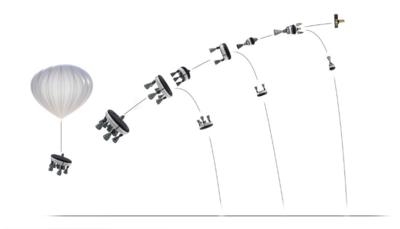'Rockoon' Will Carry Boosters To Send Small Satellites Into Orbit
Barcelona, Spain-based zero2infinity has been working to expand its capabilities to include a nanosatellite launch vehicle, named bloostar, to offer reliable, dedicated, launch on demand for 21st century small satellites.

zero2infinity has been operating high-altitude balloons since 2009. Flying technical, scientific and commercial payloads to over 30km (approx. 18.6 miles) altitude is its current operational activity. Using balloons as a first-stage for a nanosatellite launcher is the logical and necessary next step to address this booming and underserved market.
“Nanosatellites today need to fly as secondary payloads, and hitchhike their way into orbit," said José Mariano López-Urdiales, CEO and Founder of zero2infinity. "We have been working on the idea for bloostar for years. Now the technology on both the satellite and launch vehicle sides is mature enough to make it happen. Many new successful companies have business plans based on nanosatellites, like Skybox Imaging, but the dedicated launcher that they would need, doesn’t exist yet. The launch industry needs to be transformed and adapt to the real necessity of providing small payloads with the flexibility to pick their own orbit and their launch date. We believe bloostar, as the first orbital rockoon, is the solution for clean, cost-effective and sustainable space access.”
The rockoon concept presents tremendous advantages. The fact that the rocket does not need to travel through the denser parts of the atmosphere and that it ignites in close-to-vacuum conditions translates into lower drag, smaller gravity losses and much higher specific impulse due to the more effective use of nozzles. The simplicity of the system, with common elements and with no turbopumps, ensures the lowest unit cost for a dedicated microsatellite launch, comparable to what secondary payloads pay today to fly piggyback.

bloostar is the cleanest and most efficient launcher on the market, with very little energy wasted and thus limiting any polluting effect on the atmosphere. Helium and batteries are used as first stage, while ignition only happens while already above 99 percent of the mass of the atmosphere. The amount of propellant needed is much lower as for a ground or even an airborne launch.
Several microsatellite manufacturers have already expressed their intention to launch with bloostar once it will be operational, which should happen by 2017, totaling over $200 million in pre-sales.
Preliminary testing of the system has already started. In September 2013, an inflatable flexible pressurized vehicle flew to 27km (approx. 17 miles) under a balloon. This technology will be used for the lightweight tanks of the launcher. Furthermore, a test version of the pressure-fed light hydrocarbon/oxygen engine was first fired in Spain in September 2014, with satisfactory results. The engine was ignited several times and the cooling system functioned well. Following this first firing, a few modifications are being introduced before planning a new series of tests. This was the first ignition of a privately developed and funded liquid rocket engine in Spain.
(Images provided by zero2infinity)

 Airborne 07.21.25: Nighthawk!, Hartzell Expands, Deltahawk 350HP!
Airborne 07.21.25: Nighthawk!, Hartzell Expands, Deltahawk 350HP! ANN's Daily Aero-Term (07.27.25): Estimated (EST)
ANN's Daily Aero-Term (07.27.25): Estimated (EST) ANN's Daily Aero-Linx (07.27.25)
ANN's Daily Aero-Linx (07.27.25) NTSB Final Report: Luce Buttercup
NTSB Final Report: Luce Buttercup Classic Aero-TV: 'That's All Brother'-Restoring a True Piece of Military History
Classic Aero-TV: 'That's All Brother'-Restoring a True Piece of Military History





